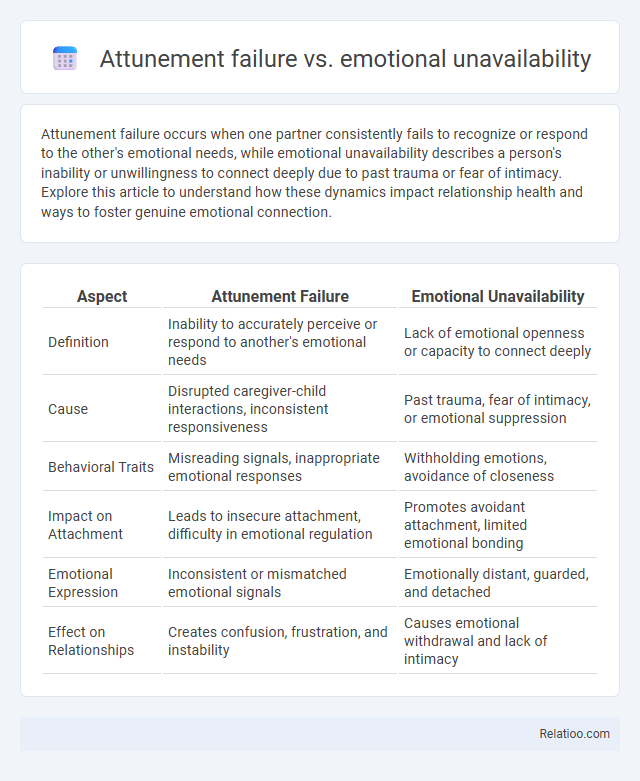Attunement failure occurs when one partner consistently fails to recognize or respond to the other's emotional needs, while emotional unavailability describes a person's inability or unwillingness to connect deeply due to past trauma or fear of intimacy. Explore this article to understand how these dynamics impact relationship health and ways to foster genuine emotional connection.
Table of Comparison
| Aspect | Attunement Failure | Emotional Unavailability |
|---|---|---|
| Definition | Inability to accurately perceive or respond to another's emotional needs | Lack of emotional openness or capacity to connect deeply |
| Cause | Disrupted caregiver-child interactions, inconsistent responsiveness | Past trauma, fear of intimacy, or emotional suppression |
| Behavioral Traits | Misreading signals, inappropriate emotional responses | Withholding emotions, avoidance of closeness |
| Impact on Attachment | Leads to insecure attachment, difficulty in emotional regulation | Promotes avoidant attachment, limited emotional bonding |
| Emotional Expression | Inconsistent or mismatched emotional signals | Emotionally distant, guarded, and detached |
| Effect on Relationships | Creates confusion, frustration, and instability | Causes emotional withdrawal and lack of intimacy |
Understanding Attunement Failure
Understanding attunement failure involves recognizing missed emotional connections where one partner cannot accurately perceive or respond to the other's emotional needs, leading to feelings of disconnection. Unlike emotional unavailability, which reflects a deliberate or unconscious withdrawal from intimacy, attunement failure often stems from miscommunication or unresolved personal trauma impacting emotional synchronization. You can address attunement failure by fostering open communication and empathy, improving emotional responsiveness that strengthens relationship bonds.
Defining Emotional Unavailability
Emotional unavailability refers to an individual's inability or refusal to connect deeply with their own emotions or those of others, often resulting in detachment and difficulty forming intimate relationships. Attunement failure occurs when one person fails to accurately perceive or respond to another's emotional state, leading to miscommunication and feelings of neglect. While emotional unavailability is an internal state or defense mechanism, attunement failure is an interactional breakdown between two parties, highlighting distinct but related challenges in emotional connection.
Key Differences Between Attunement Failure and Emotional Unavailability
Attunement failure occurs when a caregiver consistently misreads or disregards a child's emotional signals, disrupting the development of secure attachment and emotional regulation, whereas emotional unavailability describes a caregiver's lack of emotional presence or responsiveness due to personal distress or detachment. Key differences include the cause--attunement failure stems from insufficient sensitivity and understanding, while emotional unavailability is linked to emotional withdrawal or trauma in the caregiver. As a result, attunement failure impacts the accuracy of emotional communication, while emotional unavailability affects the caregiver's ability to provide emotional support and comfort consistently.
Causes of Attunement Failure
Attunement failure primarily stems from caregivers' inconsistent or inadequate emotional responsiveness, often due to stress, unresolved trauma, or lack of emotional awareness. Emotional unavailability, while overlapping, usually involves deliberate withdrawal or emotional suppression as a protective mechanism, contrasting the inadvertent neglect seen in attunement failure. Understanding these causes highlights the critical role of caregiver mental health and emotional education in preventing attachment disruptions.
Roots of Emotional Unavailability
Emotional unavailability often stems from deep-seated attunement failures during early childhood, where caregivers failed to consistently recognize and respond to a child's emotional needs. These attunement failures disrupt the development of secure attachment, causing individuals to struggle with recognizing and expressing emotions in adult relationships. Your understanding of these roots is essential for addressing emotional barriers and fostering healthier emotional connections.
Impact on Relationships and Emotional Health
Attunement failure disrupts emotional connection by causing misunderstandings and feelings of neglect, which can erode trust and intimacy in relationships. Emotional unavailability leads to emotional distancing, resulting in partners feeling unsupported and isolated, intensifying relational distress and increasing the risk of anxiety or depression. Both attunement failure and emotional unavailability impair emotional health by fostering chronic stress, reducing emotional regulation, and weakening bonding essential for healthy relationship dynamics.
Recognizing the Signs of Each
Recognizing the signs of attunement failure involves noticing a consistent lack of emotional responsiveness or misreading subtle cues during interactions, often leading to feelings of disconnection. Emotional unavailability is characterized by a tendency to avoid emotional intimacy, difficulty expressing feelings, and a pattern of distancing behaviors that hinder deep relational bonds. Distinguishing between attunement failure and emotional unavailability requires observing whether the issue stems from momentary lapses in emotional connection or a persistent reluctance to engage emotionally.
Healing from Attunement Failure
Healing from attunement failure requires recognizing emotional unavailability as a barrier to authentic connection and addressing it through consistent empathy and vulnerability. Your progress depends on cultivating emotional awareness and practicing attuned responses to rebuild trust and intimacy. Therapeutic interventions such as mindfulness and attachment-based therapy help repair disrupted emotional bonds and promote healthier relational dynamics.
Overcoming Emotional Unavailability
Overcoming emotional unavailability requires recognizing the difference between attunement failure, where one struggles to connect due to misreading emotional cues, and emotional unavailability, characterized by a conscious or unconscious withdrawal from intimacy. Therapeutic approaches such as cognitive-behavioral therapy and mindfulness practices help individuals develop emotional awareness and improve communication skills. Building secure attachment patterns through consistent emotional responsiveness fosters deeper connections and reduces relational distress caused by emotional unavailability.
Building Emotionally Healthy Connections
Attunement failure occurs when one person consistently misses or misinterprets another's emotional cues, leading to feelings of disconnection and misunderstanding. Emotional unavailability, characterized by avoidance of emotional intimacy, often results from past attunement failures and hinders the development of trust and vulnerability. To build emotionally healthy connections, you must cultivate active listening, empathy, and consistent responsiveness to emotional needs, fostering a secure environment where authentic bonds can thrive.

Infographic: Attunement failure vs Emotional unavailability
 relatioo.com
relatioo.com